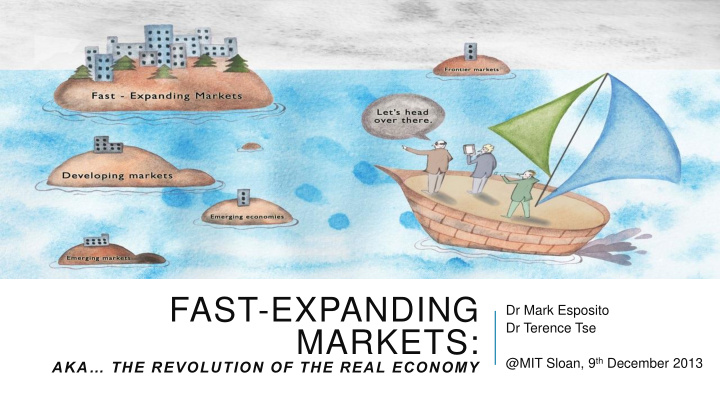



FAST-EXPANDING Dr Mark Esposito Dr Terence Tse MARKETS: @MIT Sloan, 9 th December 2013 AKA… THE REVOLUTION OF THE REAL ECONOMY
1) WHO ARE WE? The Good The Bad The Ugly 2
1) WHAT ARE WE GOING TO TALK ABOUT? FAST-EXPANDING MARKETS (FEM) What is it? Why should we care? • To sum up in one sentence: • They are where the next Business entities that are business opportunities are growing at exceptional speed • The problem is that we have lots • They bring benefits to of problems finding them themselves as well as the immediate environments and societies 3
1) WHAT WE HAVE DONE SO FAR? Issue 2 \\ 2013 MAXIMISING HUMAN CAPITAL T oday’ s Multi-Generational Workforce \\ Can They Work Together? The Owen Perspective \\ View from the Top Fast Expanding Markets \\ Looking at Global Markets 4
2) WHAT KIND OF PROBLEMS ARE WE FACING WHEN LOOKING FOR NEW OPPORTUNITIES? Traditional financial modelling – driven mostly by macroeconomics A. The relevance and importance of BRICs are diminishing – fast B. C. Just because you don’t see - them, it does not mean they don’t exist 5
3) SO, WHAT ARE FEM REALLY? WHAT ARE THEIR CHARACTERISTICS? A. FEM are fast-growing business entities – previously 15% profit growth per year but we were wrong B. FEM are “hidden champions” – little known if not unknown to many C. FEM can exist at all levels business, whether it is an industry, region, cluster, firm or even product – there is currently no term in existence that can be so encompassing “FEM, you gonna forever. You gonna learn how to fly, HIGH!” 6
4) EXAMPLE 1: CHOCOLATE PRODUCTION IN INDIA • India has a favorable climate for Cocoa production (hot and humid) • The country accounts for less than 2% of the world production of Cocoa (South of India) • Import tariffs (30-45%) therefore production in country is a possibility • Factory around populated areas: Mumbai, Goa, Bangalore, Delhi , Ahmedabad • Potential Cluster: Mumbai • Production, manufacturing, packaging, logistic & retailer, Chocolate Academy • Do you want to see a graph of it? 7
4) EXAMPLE 1: CHOCOLATE PRODUCTION IN INDIA 2008: Second Growth Spike (of 27% p.a.) was due to a combination of factors : Growth rate expected between 25 % 1) Advertising showed increased effect to 35% p.a. 2) Increase in raw material prices (especially sugar ) which made traditional sweets slightly more expensive 3) Shift away from traditional sweets to chocolate: - Preferences - Rising income - Seen as healthier choice 2010: Aggressive strategy of - Seen as a part of a “Western Lifestyle” Kraft 2015: size of Indian - Ease of use chocolate industry: USD$ ~ 2.1-2.8 billion Size of Indian chocolate industry : USD$ 418 million 2011: size of Indian chocolate industry: USD$ 857 million 1948: Cadbury starts operations in India 1 year after independence 2007: First growth initiated due to main factor: - Importing 1) Chocolate advertising rose by 30% from the big chocolate producers - Gradual manufacturing due to high tariffs Top Advertisers: (30-45%) - Cadbury (66%) - Nestle (27%) - Others (7%) 1948 - 2005 2006 - 2007 2008 - 2012 2013 2013 - 2016
4) EXAMPLE 2: IVOCLAR VIVADENT • Turnover of CHF 633 million in 2011, supplying ceramic teeth to 120 countries • 2,500 employees worldwide • Developed integrated clusters by partnering with renowned institutions and universities to develop integrated concepts, resulting in innovative solutions • Double digit growth in nearly all global markets: Europe up 10%, North America up 19%, Asia up 19% 9
4) EXAMPLE 3: SBOING • High-tech firm from Greece – no oxymoron • Collaborative route information collection that leads to enhancement in drivers’ decisions • Subscription-based that work on Androids and iOS • Other companies in Greece using high-tech include Taxibeat and Incrediblue 10
Adult Diaper Marke ket t in 4) ADULT DIAPERS Japan an 172 billons JPY ( approx. 2 bl USD) 200000 27.59 % 180000 is estimated for factory shipping based 2007-2012 160000 revenue with 5% of average annual 140000 growth rate since 2007. (by Yano Research Institute YRI) 120000 100000 Remarkable Phenomena 80000 Adult Diaper Market exceeded Baby 60000 Diaper market for the first of the history in 40000 2012. (by YRI) 20000 0 2007 2012 11
4) HOW WOULD IT LOOK LIKE IF WE INFOGRAPHIC IT? 12
4) ARE THERE ANY OTHER EXAMPLES? OH YES i. Light-Emitting Diodes (LEDs) in Japan ii. Aerospace manufacturing in Mexico iii. Mango growing in Mali iv. Cattle-ranching in Paraguay v. Green roofs in US vi. Biostoves in Kenya vii. Vitamin D test market in Italy viii. Cosplay and manga from Japan ix. Zambeef in Zambia, Ghana and Nigeria x. Paper manufacturing cluster in Lucca, Italy xi. Carbon-fibre chassis for racing cars manufacturing near Palma, Italy 13
5) THE IMPORTANCE AND IMPLICATIONS OF FEM • FEM represent new opportunities for investors • FEM show new ways for finding out why a business entity succeed • FEM are sources of growth and innovation, the two real drivers of competitiveness • FEM are crucial in solving the Eurozone crisis • FEM demonstrate that there is no such thing as “economic recession” but only “individual recession” 14
6) IDENTIFYING THE NEXT FEM • Identifying the next FEM is not necessarily hard work but can be time consuming • Cannot rely on macroeconomic and therefore quantitative data • Dedicated person to search for FEM and analyse the reasons for the rise (and success) 15
LET’S TALK • Sponsored by KPMG/ESCP Europe Chair Governance, Strategy, Risks, and Performance • Thank you very much for listening • Questions and (hopefully) Answers • www.mark-esposito.com @Exp_Mark • www.terencetse.com @ Terencecmtse 16
Recommend
More recommend